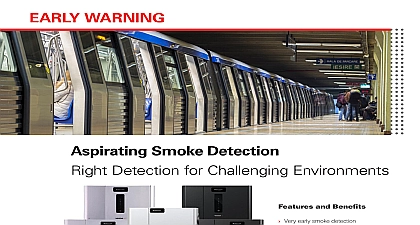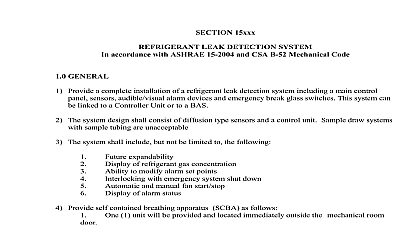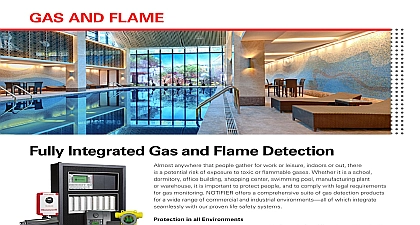Notifier Video Smoke Detection White Paper

File Preview
Click below to download for free
Click below to download for free
File Data
| Name | notifier-video-smoke-detection-white-paper-3104297658.pdf |
|---|---|
| Type | |
| Size | 685.66 KB |
| Downloads |
Text Preview
Video Smoke Detection based automatic fire detection is the latest technology to identify the presence of smoke or fire in areas previously to be impractical for typical smoke detection Traditional and fire detection methods require the fire signatures such as or heat to travel to the device whereas Video Smoke Detection detects the fire at the source Its ability to detect fire remains of architectural and environmental conditions that affect detection methods detectors and sensors are designed to look at one or more of the from fire or the incipient stages of fire most commonly followed by heat In most typical commercial and industrial these detection principles work very well However these detection methods may not be able to provide adequate in unique structures and specialized facilities such as pro plants tunnels aircraft hangers mass transit facilities historic or areas that are inaccessible or unsafe for spot type Based on the intended purpose of the building the types operations and processes it must contain the design may not be to detecting smoke or fire with standard detection methods like vast open areas atria high ceilings can severely dimin the effectiveness of spot type smoke and heat detectors as well beam type smoke detectors VSD excels in all of these environ without any compromise to alarm response time It can detect and or fire in any area visible to a standard video camera even window or door glass Affecting Traditional Methods Smoke Detection automatic smoke detectors or sensors rely on smoke or heat signatures reaching the device before it can start the decision making process with the fire alarm control This process can be affected by one or more of the following Distance from Fire Source to Detector and heat detectors are normally sited in a position that smoke will travel to typically the ceiling The distance from the detector any area on the floor is usually the maximum distance allowed in with local or national fire codes These codes are calculat from an acceptable time delay for the smoke to reach the detector any area Once the smoke reaches the detection point it has to up sufficient density to activate the detector Even with the aspi systems that draw the sampled air to the detector the smoke has to reach the sampling point which would normally be placed the same position as standard detectors Stratification will rise because it is hotter than the surrounding air As the travels through the cooler air it will in turn cool down Once smoke approaches the same temperature as the air around it smoke will stop rising This process is known as stratification the detectors are above this stratification level then they will not the smoke until a significant amount of heat generated from growing fire moves the stratification level higher and higher This the reason international standards will state a limitation on ceiling for certain types of smoke detectors This can be as low as feet for spot type heat detectors twenty five feet for spot smoke detectors or thirty feet for beam type smoke detectors Thermal Barriers rises Therefore the hottest air will be found at the highest point the room This will create a barrier of hot air which smoke will only if it has a higher temperature than this barrier This is very in glass ceiling areas such as atria found in shopping malls high rises Diffusion smoke rises it will tend to drift sideways as well as upwards the concentration of smoke will be lower as the smoke Smoke sensors are designed to alarm when smoke levels reach certain percent obscuration measurement dependent on the of smoke at the detector location The more smoke the longer it will take for the concentrations levels to reach detector alarm activation threshold Air Movement air movement will take smoke away from the source of the fire is not a problem if you can predict the exact route of the air In computer rooms control rooms and clean rooms this usually known and detectors can be placed across air conditioning etc There will however be the need for additional ceiling in Life Safety Technology after the airflow has stopped e g air conditioning switched and the smoke takes its traditional vertical path toward the ceiling the protected areas be external or an area with similar envi such as an aircraft hanger that has large doors open then would be no predictable airflow At Source Detection Methods VSD other at source type detectors are Thermal Imaging Cameras These systems can detect changes temperature by monitoring infrared emissions They can be useful a controlled environment where there are no other forms of unpre heat sources They are impractical areas where heat sources as people cars and machinery are moving through the scene Image Processing of Heat Changes These systems work by a heat sensitive pad to known risk areas These heat pads will color or contrast with the increase in temperature This change then be monitored and processed via a thermal imaging camera Flame Detectors The most popular at source fire detection sys in this category are flame detectors The difficulty with flame is that by the time flames appear to trigger the device into serious fire damage has occurred and will rapidly increase also amounts of smoke may have been emitted causing serious to personal health Smoke Detection Principle of Operation first developed in the late 1990s is based on sophisticated com analysis of the video image seen by a standard CCTV camera Using advanced image processing technology and extensive algorithms and known false alarm phenomena the VSD can identify the distinct characteristics of smoke and flame The fire detection industry has an abundance of known and flame phenomena such as frequency of flicker and all of factors are built into the system to give an accurate decision on smoke and or flames are present The VSD system is so accu in its analysis that it can differentiate between steam and smoke VSD system uses standard CCTV cameras back and white color existing or new linked to a self contained processing system is capable of recognizing small amounts of smoke and flame within the video image and alerting the system operator both the processor and by a variety of remote outputs VSD system executes highly complex algorithms to process video from up to eight cameras simultaneously Under normal with all eight cameras connected the system achieves 5Hz frame rate for each channel in Life Safety Technology VSD system detects smoke and flame rapidly by looking for areas of change within the image at the digitization stage and passing these pixel changes to the main processor for further video information is passed through a series of filters that seek characteristics associated with smoke and flame behavior analysis is then carried out on the relationships between the characteristics to determine whether all the conditions have met for the system to accurately predict the presence of smoke flame video hardware is designed to allow simultaneous real time of all eight images which means that the system does multiplex images and therefore no information is lost or delayed alarm condition images are log time and date stamped and stored the system memory system installer has the ability to vary the amount of smoke and the length of time that the smoke exists before an alarm is raised to allow for situations where there may be back smoke present The installer may also divide the video image zones and program the system to alarm only if smoke and or are present in two or more zones even greater system performance two camera images can be together so smoke and or flame in one image is to be as a pre alarm and smoke and or flame in the second image triggers a full alarm compensate for areas of the image that could prove troublesome as reflective surfaces or smoke producing processes the or system user has the ability to eliminate or mask parts the image from detection on an individual pixel by pixel basis of Video Smoke Detection VSD Investigation and False Alarm Rejection ability of VSD to pinpoint the source of a fire on a camera monitor an operator or security staff view the area affected and assess severity of the situation without delay This can be done at a very stage to allow the operator to view the camera image after a or sounder is triggered locally and then take necessary action ultimate evacuation of the building can be delayed to allow an the time to verify and if necessary r


